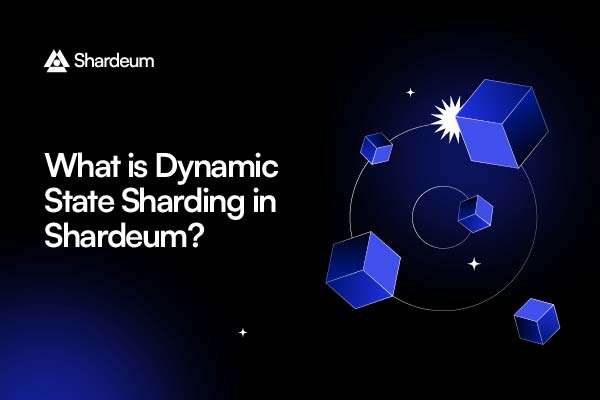Dynamic State Sharding: Revolutionizing Scalability in Shardeum
 Nikhil Kumar
Nikhil KumarTable of contents
- Introduction
- 1. Dynamic State Sharding and Shardeum's Scalability Revolution
- 2. Sharding Unveiled
- 3. Dynamic State Sharding by Shardeum
- 4. How Shardeum Takes the Lead
- 5. Dynamic State Sharding vs. Adaptive State Sharding
- 6. Atomic Processing and Low Gas Fees
- 7. Linear Scaling and Web3 Advancements
- 8. Conclusion

Introduction
Dynamic State Sharding in Shardeum is a cutting-edge solution to address the challenges of scalability in the world of blockchain. With the rapid growth of the cryptocurrency user base, existing blockchains are struggling to handle the scale of adoption. Traditional layer one (L1) blockchains are not inherently designed to support such a massive user base. Some L1 blockchains have attempted to scale up but often compromise decentralization and security, which are core principles of open-source technology.
Additionally, increasing block sizes or implementing layer two (L2) solutions bring their own set of issues. It's becoming clear that vertical scaling with more hardware resources is not enough to achieve mass adoption. Permissionless blockchains have made Moore's law, which used to predict consistent growth in computing power, unpredictable in the context of distributed computing networks.
So, how does sharding come into play as a solution to this scalability challenge? Dynamic State Sharding in Shardeum provides a way to partition the blockchain network into smaller, more manageable pieces or "shards." This approach can significantly enhance the scalability of the network without compromising decentralization and security, making it a promising solution for addressing the scalability trilemma problem that blockchain platforms face.
1. Dynamic State Sharding and Shardeum's Scalability Revolution
The world of blockchain is rapidly evolving, with more users joining the crypto community than ever before. This growth, however, has exposed the limitations of existing blockchain networks. Current layer one (L1) blockchains struggle to handle the immense scale of users, leading to challenges in achieving mass adoption. But there's hope on the horizon. One promising solution is dynamic state sharding, a game-changing approach to scalability. This article explores dynamic state sharding, its role in the blockchain ecosystem, and how Shardeum is pioneering this innovation.
2. Sharding Unveiled
Before delving into dynamic state sharding, let's break down the concept of sharding. Sharding involves partitioning a network's computational and storage workload, allowing individual nodes to handle specific transactional loads. This technology divides the task of validating and confirming transactions into more manageable components, with each node maintaining information related to the transactions it handles.
Sharding is not a new idea, it's been employed in various blockchain networks like Polkadot and Zilliqa. However, Shardeum introduces a groundbreaking approach that sets it apart from the rest.
3. Dynamic State Sharding by Shardeum
Shardeum's dynamic state sharding approach is set to transform the way blockchain networks handle scalability, decentralization, and security. Unlike traditional static state sharding, where nodes are fixed in predefined shards, dynamic state sharding offers a more agile and responsive solution. In Shardeum, nodes can move and adapt, accommodating more data as dynamic shards. This dynamic approach pairs seamlessly with Shardeum's auto-scaling feature, allowing the network to automatically adjust the number and size of shards based on the current workload. The result is a system that optimizes performance and maintains high levels of scalability as it evolves, effectively addressing the blockchain trilemma.
One of the key advantages of dynamic state sharding is the efficient and parallel processing of transactions. In Shardeum, validator nodes are assigned dynamic address ranges across multiple shards. Unlike static state sharding, where all nodes within a shard cover the same address range, dynamic state sharding assigns unique ranges to each node with significant overlap. As a result, transactions that affect multiple shards are processed simultaneously, reducing transaction processing time and ensuring atomic processing. Additionally, Shardeum is committed to achieving cross-shard composability, enhancing the network's overall efficiency and functionality. This innovative approach positions Shardeum as a leading force in addressing the scalability challenges faced by blockchain networks.
4. How Shardeum Takes the Lead
Shardeum's dynamic state sharding takes the concept to the next level. Unlike sharded blockchains like Zilliqa, which achieve consensus at the block level, Shardeum attains consensus at the transaction level. This means that a transaction doesn't have to wait for consensus across multiple shards to process. Transactions are executed simultaneously, reducing processing time and ensuring atomic processing.
Dynamic state sharding allows Shardeum to distribute the load efficiently and proactively across the network. This algorithm takes into account historical transaction data, enabling Shardeum to predict potential overloads and balance the load across shards. This leads to faster transaction processing, even during high traffic periods, and supports cross-shard composability.
😀Want to know more about sharding? Check our detailed guide on Types of Sharding in Blockchain.
5. Dynamic State Sharding vs. Adaptive State Sharding
In the world of blockchain scaling solutions, adaptive state sharding, as seen in networks like MultiversX (formerly Elrond), represents a significant advancement beyond traditional static state sharding. Adaptive state sharding, a more sophisticated approach, tailors the number and size of shards based on the current state of the network. Factors like the number of nodes in the network and the volume of data being processed dictate these adjustments. For instance, when there's a sudden surge in transaction volume, a network employing adaptive state sharding can automatically create additional shards to handle the increased load. This method ensures swift and efficient transaction processing, even during periods of high traffic, thanks to parallel execution. Adaptive state sharding aims to bring together the advantages of state, network, and transaction sharding. However, it operates reactively, responding to the current state of the network rather than proactively addressing the global state of the entire network.
Dynamic state sharding takes adaptive state sharding to the next level by optimizing the distribution of the network's load both efficiently and proactively. It evenly shards the state, network, and transactions, considering not only the current network state but also the global state of the entire blockchain. This global state encompasses the latest state, transaction history, and every historical state of the network. For instance, a dynamic state sharding algorithm tracks the average number of transactions processed by each shard over time. This valuable data can then be used to predict which shards are likely to face increased loads in the future. The algorithm takes preemptive measures to distribute the load evenly across the shards. Another scenario could involve recognizing that specific types of transactions are typically processed by specific shards. In response, the algorithm proactively routes new transactions to the appropriate shards, optimizing network efficiency and load distribution.
6. Atomic Processing and Low Gas Fees
In the dynamic world of sharding and blockchain, Shardeum introduces a vital concept - Atomic Processing and Cross-Shard Composability. This innovation allows transactions to access and utilize data and state from various shards, paving the way for complex transactions and smart contracts to be executed efficiently within a sharded environment.
"Atomic composability" is a key component of this. It ensures that transactions are executed atomically, meaning that every part of a transaction is executed successfully, or none of them are. This guarantees a high level of reliability and consistency in the blockchain. Without atomic composability, transactions could risk failure or leave the blockchain in an inconsistent state, leading to potential security issues.
Shardeum's commitment to implementing these features ensures that even the most intricate transactions and smart contracts are executed effectively within a sharded environment, maintaining the integrity and reliability of the entire blockchain ecosystem.
7. Linear Scaling and Web3 Advancements
Dynamic state sharding allows Shardeum to scale linearly. With every new node added to the network, transaction throughput increases instantly. Shardeum aims to mobilize millions of nodes, potentially processing over one million transactions per second. This scalability positions Shardeum as a groundbreaking solution in the Web3 ecosystem.
8. Conclusion
Dynamic state sharding is at the forefront of blockchain innovation, and Shardeum is leading the charge. By combining dynamic state sharding with its auto-scaling feature, Shardeum aims to solve the blockchain trilemma once and for all. The network strives to outperform Web2 networks in terms of throughput capacity while upholding the high standards of security and decentralization expected from Web3 networks. These are indeed exciting times for the world of Web3, and Shardeum is poised to make a significant impact. Stay tuned for the future of blockchain scalability!
If you are interested in learning more about Shardeum or getting involved in the project, you can join the community on Telegram channel, follow the Twitter page and join the Discord channel. You can also find more information on the Shardeum Website.
Shardeum Rewards Developers for Their Contributions.
Shardeum, the decentralized application platform, is committed to rewarding developers for their contributions to the project. The company offers a variety of community reward programs.
To learn more about the available community reward programs, please visit the Community Reward Programs page.
Thank you for Reading! ❤️
Subscribe to my newsletter
Read articles from Nikhil Kumar directly inside your inbox. Subscribe to the newsletter, and don't miss out.
Written by
